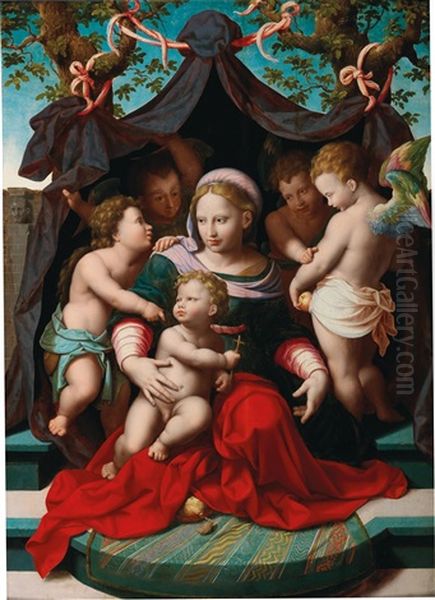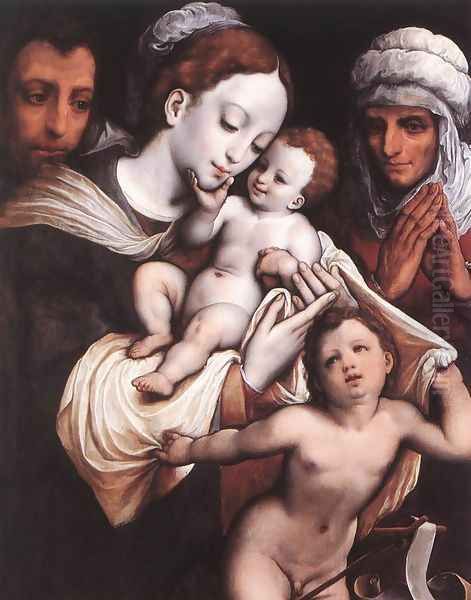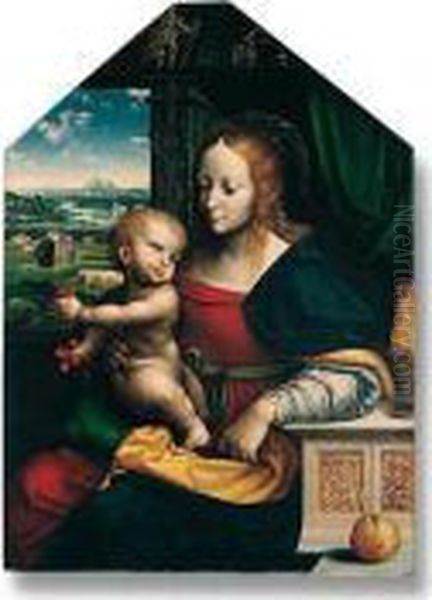Cornelis van Cleve, a name that resonates with both artistic talent and poignant human drama, occupies a specific niche in the vibrant tapestry of 16th-century Netherlandish art. Born in the bustling artistic hub of Antwerp around 1520, he was destined to navigate the complex currents of a rapidly evolving art world, inheriting a significant legacy while striving to forge his own identity. His life, tragically cut short in 1567, offers a compelling study of artistic inheritance, the pervasive influence of the Italian Renaissance in Northern Europe, and the devastating impact of personal misfortune on a promising career.
The Inheritance of a Flourishing Workshop
Cornelis was the son of Joos van Cleve (formerly known as the Master of the Death of the Virgin, c. 1485 – c. 1540/1541), one of Antwerp's most successful and internationally renowned painters of the early to mid-16th century. Joos's workshop was a prolific enterprise, producing a wide array of works, from devotional paintings and altarpieces to striking portraits that captured the likenesses of European royalty, including Francis I of France. Joos van Cleve's style was a sophisticated amalgamation of the meticulous detail and rich oil glazes characteristic of Early Netherlandish masters like Jan van Eyck and Rogier van der Weyden, with the burgeoning influences of the Italian Renaissance, particularly the soft modeling of Leonardo da Vinci and the compositional harmony of Raphael.
Growing up in this environment, Cornelis was immersed in the techniques and artistic vocabulary of his father's studio from a young age. It is almost certain that he received his primary artistic training under Joos, absorbing the workshop's established patterns for popular subjects like the "Holy Family," "Adoration of the Magi," and "Madonna and Child." Upon Joos van Cleve's death around 1540 or 1541, Cornelis, then a young man of about twenty, inherited the workshop. This was a considerable responsibility, involving not only the continuation of artistic production but also the management of assistants and the fulfillment of existing commissions. He endeavored to maintain the high standards and stylistic tendencies that had brought his father such acclaim.
Artistic Style: Northern Traditions and Italian Aspirations

Cornelis van Cleve's artistic output, particularly in his early career, naturally shows a strong stylistic continuity with the work of his father. He adeptly replicated and adapted Joos's successful compositions, demonstrating a fine technique and a keen understanding of color and detail. Religious subjects, especially depictions of the Virgin and Child, remained a cornerstone of his production, catering to the persistent demand for devotional imagery. These works often feature the sweet, idealized facial types and tender interactions that characterized his father's popular renderings of these themes.
However, Cornelis was not merely an imitator. As his career progressed, he increasingly demonstrated a personal engagement with the artistic innovations emanating from Italy. The influence of High Renaissance masters, which his father had already begun to absorb, became even more pronounced in Cornelis's work. He showed a particular affinity for the sfumato technique – the subtle, smoky blending of tones and colors to create soft outlines and atmospheric depth – most famously associated with Leonardo da Vinci. This lent his figures a gentle, almost ethereal quality. Furthermore, the harmonious compositions and graceful figures of Raphael and his followers, as well as the dynamic compositions and rich colors of Venetian painters like Titian, seem to have informed his evolving style.
While the provided text mentions "Baroque," it's more accurate to situate Cornelis firmly within the Northern Renaissance, with strong Mannerist tendencies emerging in Antwerp during his lifetime. The dramatic intensity and dynamism of the full-blown Baroque would arrive later. Cornelis's work, rather, reflects the period's fascination with Italianate elegance, elongated forms, and complex, often emotionally charged, compositions, all filtered through a Northern sensibility for detailed realism.
Representative Works: The Madonna of the Lily
One of Cornelis van Cleve's most notable and discussed works is the Madonna of the Lily, painted around 1550 and currently housed in the collection of the Banco de España. This painting is particularly significant as it is a version of a composition by the Florentine High Renaissance master Andrea del Sarto. The existence of such a copy highlights the common practice of artists studying and replicating the works of esteemed Italian masters, a crucial method for disseminating Renaissance ideals throughout Europe.

Cornelis did not simply create a slavish imitation. While adhering to the overall compositional structure of Andrea del Sarto's original, he introduced subtle but meaningful alterations. Art historians note that he adjusted the positioning of the Christ Child and the Virgin, potentially to enhance the emotional intimacy of the scene or to better suit the devotional preferences of his Northern clientele. These modifications demonstrate his capacity for creative interpretation and his desire to imbue established models with his own artistic sensibility. The painting showcases his skill in rendering tender expressions, soft flesh tones, and the delicate interplay of light and shadow, characteristic of his mature style. Other works often attributed to him or his workshop include various versions of the Adoration of the Magi and numerous Holy Family compositions, which often echo the successful formulas established by his father but with a discernible softness and elegance that can be attributed to Cornelis's hand.
The Ill-Fated English Sojourn and "Sotte Cleef"
A pivotal and ultimately tragic chapter in Cornelis van Cleve's life was his decision to move to England. This likely occurred sometime after his father's death, perhaps in the mid-1550s. The exact reasons for this move are not definitively documented, but it was a period when England, under Queen Mary I and her husband Philip II of Spain (who became King of England jure uxoris), was a potential, if somewhat unstable, market for artists. Philip II was a significant art patron, and many Netherlandish artists sought opportunities at foreign courts. Cornelis may have hoped to secure patronage from the English court or the wealthy nobility.
Unfortunately, his time in England did not bring the success he anticipated. According to the early Netherlandish art historian Karel van Mander in his Schilder-boeck (Book of Painters) of 1604, Cornelis van Cleve suffered a severe mental breakdown while in England. Van Mander reports that Cornelis became convinced that his artistic talents surpassed those of any other painter, including the great Italian masters. This delusion, coupled with a lack of recognition and perhaps financial difficulties, led to a decline in his mental health. He earned the tragic moniker "Sotte Cleef" or "Mad Cleef." This mental instability effectively ended his promising career. He is believed to have returned to Antwerp, where he died in 1567, at the relatively young age of 47, his artistic potential unfulfilled due to his illness.
Contemporaries and the Antwerp Art Scene
Cornelis van Cleve operated within one of Europe's most dynamic artistic centers. Antwerp in the 16th century was a melting pot of artistic styles and a hub for international trade, which brought wealth and a demand for art. He would have been aware of, and in some ways competing with, a host of talented painters.
His most immediate artistic relationship was, of course, with his father, Joos van Cleve. The workshop system meant collaboration was inherent. Beyond his father, the Italian masters like Leonardo da Vinci, Raphael, and Andrea del Sarto were profound, if distant, influences, their works known through prints, drawings, and original pieces that made their way north.

In Antwerp itself, the dominant figure during Cornelis's mature period was Frans Floris (c. 1519/1520 – 1570). Floris, a contemporary of Cornelis, was a leading proponent of Romanism, having studied in Italy and returned to Antwerp to run a large, influential workshop that produced grand-scale history paintings in a thoroughly Italianate style. While direct collaboration or documented rivalry between Cornelis and Floris is not explicitly recorded, they were key figures in the same artistic milieu, representing different facets of Antwerp's engagement with the Renaissance.
Other significant painters active in Antwerp or the broader Netherlands during this era included:
Pieter Bruegel the Elder (c. 1525–1569), whose focus on peasant life and landscape offered a distinct path from the Italianate history paintings.
Marten de Vos (1532–1603), another prominent Romanist who, like Floris, had a highly successful workshop.
Jan Sanders van Hemessen (c. 1500 – c. 1566), known for his genre scenes and religious paintings with a robust, sometimes Mannerist, character.
Pieter Aertsen (1508–1575), a pioneer of genre painting, particularly market and kitchen scenes, often with religious scenes in the background.
Lambert Lombard (1505–1566), an influential artist and theorist from Liège who also played a key role in disseminating Italian Renaissance principles in the Low Countries.
Earlier figures who laid the groundwork for Antwerp's artistic prominence, such as Quentin Matsys (c. 1466–1530) and Joachim Patinir (c. 1480–1524), the latter a pioneer of landscape painting, would have still been part of the artistic consciousness.
The Van Cleve name itself was associated with other artists, such as Hendrick van Cleve III and Martin van Cleve, though their direct working relationship with Cornelis is not clearly established, the shared surname could sometimes lead to confusion in later attributions.
This vibrant, competitive environment, filled with artists exploring various stylistic avenues, formed the backdrop to Cornelis van Cleve's career.
Legacy, Confusion, and Rediscovery
For a considerable period after his death, Cornelis van Cleve's artistic identity became obscured, largely overshadowed by that of his more famous father. The shared surname and the continuation of workshop patterns meant that many works by Cornelis were either attributed to Joos or simply cataloged under the generic "School of Joos van Cleve." The tragic narrative of "Sotte Cleef," while memorable, perhaps did more to highlight his personal story than to preserve his artistic reputation.

It was not until the late 19th and early 20th centuries, with the rise of systematic art historical scholarship, that efforts were made to disentangle the hands of father and son. Art historians like Max J. Friedländer and Georges Hulin de Loo meticulously studied the oeuvres attributed to Joos van Cleve and his circle, gradually identifying stylistic nuances that allowed for the reattribution of certain works to Cornelis. This process involved careful connoisseurship, comparing brushwork, figure types, compositional preferences, and color palettes.
The rediscovery of Cornelis van Cleve has allowed for a more nuanced understanding of the Joos van Cleve workshop and the broader artistic landscape of 16th-century Antwerp. It reveals an artist who, while deeply indebted to his father's legacy, possessed a distinct artistic personality, characterized by a gentle lyricism and a refined assimilation of Italian Renaissance aesthetics. His story also serves as a poignant reminder of how personal circumstances can tragically curtail artistic development.
Conclusion: A Talented Figure in a Period of Transition
Cornelis van Cleve stands as a significant, if somewhat melancholic, figure in the history of Netherlandish art. He represents a generation of Northern artists grappling with the powerful allure of the Italian Renaissance while remaining rooted in their own rich artistic traditions. His skill in creating tender and elegant religious imagery, particularly his Madonnas, demonstrates a refined sensibility. The Madonna of the Lily remains a testament to his ability to engage creatively with prestigious Italian models.
While his career was tragically cut short by mental illness, the body of work attributable to him reveals a painter of considerable talent who successfully navigated the transition of his father's workshop and began to forge his own path. His life and art offer valuable insights into workshop practices, the dissemination of artistic styles across Europe, and the often-precarious existence of artists in the 16th century. Though perhaps not as revolutionary as some of his contemporaries, Cornelis van Cleve's contribution to the Antwerp Renaissance is undeniable, and his story adds a layer of human depth to our understanding of this vibrant artistic period.